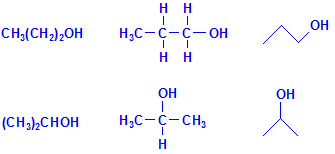There are two propanols, n-propanol and iso-propanol. N-propanol is also known as 1-propanol and propane-1-ol, and iso-propanol is known as 2-propanol and propane-2-ol. In the formulae below, the three graphics on the top line are different ways of writing the formula for n-propanol, and the three on the bottom line, of writing iso-propanol.

Isopropanol (as it is usually spelled) is more common in histology laboratories, although for most practical histological purposes the two propanols are interchangeable with each other. Isopropanol has been quite commonly used when ethanol or methylated spirits cannot be used for some reason, and it is just about as effective a dehydrant. The author was trained in a laboratory that used isopropanol as the routine processing dehydrant, and it was completely satisfactory at reasonable cost. It is not drinkable, but it is of relatively low toxicity, so much so that it is sometimes used in cosmetics and other materials sold for use in the home, including the “rubbing alcohol” used to clean new born babies’ umbilical cords.
It is not one of the alcohols recommended as a fixing agent, although it has been incorporated into fixatives on occasion. It does not complete fixation of unfixed tissues unless left for extended periods of time. Tissues inadequately fixed will have areas that did not clear or infiltrate due to the presence of water.
Both propanols, but in particular isopropanol, are miscible with paraffin wax sufficiently to be used as wax antemedia. Their major disadvantage is that they are poor fat solvents, so fatty tissues, such as breast, do not infiltrate as well as non-fatty tissue such as liver of kidney. One of their characteristics is that they do not harden the tissue very much when used this way, considerably less than xylene does. This makes them of value when a particularly hard block is encountered, and processing another piece of tissue using isopropanol, then going directly into molten paraffin wax, will often produce a block that is much less hard. The molten paraffin wax does take somewhat longer to infiltrate, but not excessively so.






